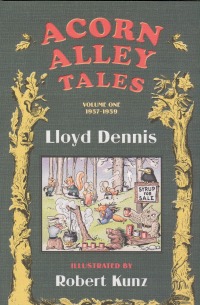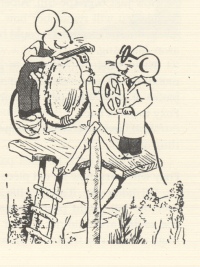| ________________
CM . . . . Volume XVIII Number 3 . . . . September 16, 2011
excerpt:
On March 17, 1957, educator Lloyd Dennis and illustrator Robert Kunz started a weekly news page for children entitled “The Children’s Corner” in The Toronto Telegram newspaper. Warmly received by children and adults alike, the stories of Acorn Alley became an important section of the weekly children’s page which continued for six years. The first two years of these stories have been collected in Acorn Alley Tales: Volume One 1957-1959.
Acorn Alley is a unique place. It is full of engaging animal characters including: Mayor Rob Rabbit, Scuff Squirrel, Polly Porcupine, Albert and Joe (the Mouse Twins), Buster Beaver, Flip Frog, Hoot the Owl, Belle Blue Jay and Foxy Fox. Life is never boring in Acorn Alley. The animals are constantly going on adventures, getting into trouble, and working together to rescue each other. When Scuff Squirrel is caught in a storm on a small ship, Flip Frog saves him from drowning. The community is a vibrant and ever changing place. Buster Beaver travels away on the river to find a wife. Old Crow moves into Acorn Alley after learning a bitter lesson about honesty. The stories of Acorn Alley – both in prose and in poetry – are full of imaginative curriculum connections for young readers. The animals invent various tools to deal with their environment – saunas, boats, catapults. pulleys, submarines and rafts. Science is alive and well in Acorn Alley, along with the spirit of innovation and imagination. The animals talk about astronomy and air travel and explore the geography of their natural environment by organizing hikes, picnics and sports events. At various times, individual animals explore the river, the corn field and the forest. They collect food for the long winter months and rejoice in the summer sunshine. But perhaps the strongest messages for young readers in Acorn Alley Tales come through the relationships between the animals. They care about each other. When Flip Frog does not appear in the springtime, the animals come to his rescue by pulling him out of the mud. The community of Acorn Alley believes in democracy and co-operation. Lloyd Dennis gained fame in Ontario as co-author of the Living and Learning report (1968) which was also known as the Hall-Dennis Report. This report changed the face of education in Ontario for years with its recommendations to individualize instruction, de-emphasize competition, and create curriculum guidelines instead of prescribed courses of study. The beginnings of these recommendations can definitely be seen in the stories of Acorn Alley Tales. The illustrations of Robert Kunz and the simple text of Lloyd Dennis show an animal world where the needs of individuals are respected, where imagination and innovation are encouraged, and where curiosity about the natural world is celebrated. Today’s readers may have difficulty relating to some of the expressions used in the text, i.e. “Bless my pretty pink apron!” The black and white illustrations may seem simplistic. Technology is also missing from this animal world. When a car invades their space, the animals call it a “monster.” However, despite these aspects, the collection is a joy to read. The short passages of prose and poetry tell stories of exciting adventures with underlying morals. The stories may be simple, but they are amusing and fun to read. They have great potential to introduce various topics of interest to very young children through read-alouds and shared reading. Topics include: friendship, co-operation, invention, exploration, woodland animals and the environment. As the seasons change, the characters develop in complexity and maturity. New readers, and those who actually remember “The Children’s Corner” from the pages of The Toronto Telegram will be equally captivated by the adventures of the woodland creatures and the lessons that can be learned from the Acorn Alley Tales! Highly Recommended. Mark Myra Junyk, a literacy advocate and author, lives in Toronto, ON.
To comment
on this title or this review, send mail to cm@umanitoba.ca.
Copyright © the Manitoba Library Association. Reproduction for personal
use is permitted only if this copyright notice is maintained. Any
other reproduction is prohibited without permission.
NEXT REVIEW |
TABLE OF CONTENTS FOR THIS ISSUE
- September 16, 2011.
AUTHORS |
TITLES |
MEDIA REVIEWS |
PROFILES |
BACK ISSUES |
SEARCH |
CMARCHIVE |
HOME |

